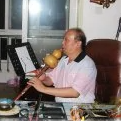Yu Tianyou

Yu Tianyou, a native of Leting, Hebei. Member of China Musicians Association, famous national wind musician. He joined the army in 1959 and served as a soloist in the General Political and Cultural Troupe of the Chinese People's Liberation Army; since 1963, he has been a soloist in the Central National Song and Dance Troupe. Since 2003, he has been the director of the China Minority Culture and Art Research Institute, the vice-chairman of the Hulusi and Bawu Professional Committee of the Chinese National Orchestra Society.
At the age of 10, he learned the flute. He was persistent and serious. He studied hard and practiced hard, and finally achieved something. After joining the professional literary and artistic team, I became more serious and hard-working. I practiced for as much as 12 hours a day. From this, I developed a solid basic skills and became an excellent solo player, able to play ※ bamboo flute, flute, ※ Xiao, ※Hulusi, ※Bau, ※Korean flute, Korean tongxiao, Korean short Xiao, Japanese shakuhachi, Tajik eagle flute, ※Jingpo Bazaar (British bagpipes), tulang, ※single string piano, ※mouth flute, xun, ※Wuchi (the improved big bamboo flute is 5 city feet long, so it is called "five feet") and other national musical instruments (the instruments marked with * are solo instruments) and form their own unique artistic style.
For more than 50 years, I have followed the performance groups to the border and the grassroots, whether it is a border post or an island hospital. Wherever there are soldiers and masses, the performances will be sent to wherever. Even if there is only one warrior, serve our warriors. Soldiers and the masses were often moved to tears. It often happens that after a performance, there are soldiers and the crowd around him wanting to learn musical instruments, but Yu Tianyou always welcomes everyone. .. affectionately called "our artist" by the warriors and the masses.
The life of art lies in innovation. In 1975, Yu Tianyou took the lead in reforming the national minority musical instrument "Hulusi", designed and produced the six-pipe cucurbit flute with two main pipes, thus ending the era that cucurbit flute could only play octaves. The history of music within the tone. Then he carried out a keyed reform on the basis of the reformed "Hulusi", and created the "Keyed 17-degree six-pipe full-tone Hulusi".
The great success in the reform of national wind instruments inspired him to carry out new reforms. In 1977, Yu Tianyou participated in the research work of the reformed production "Jiajianbawu" led by the Music Research Institute of the Academy of Arts of the Ministry of Culture, and achieved another success. He was also the first to create solo pieces for the above two improved musical instruments: "Golden Peacock" (Dai music) and "On the Grassland" (Mongolian music) and performed it himself, which was appreciated by the Ministry of Culture and won the "Chinese Bawu, Hulu" "The King of Silk".
In addition to his busy performances and research, he went to various ethnic minority areas in Yunnan to collect folk customs and experience life as many as 17 times, and composed and adapted a series of ethnic wind solo pieces. His representative works include: "Spring on the Lake", "Golden Light" "The Peacock", "On the Prairie", "Night of Guishan", "Awa New Song" and so on. Among them, the two pieces of "Spring on the Lake" and "Golden Peacock" are the highest-level pieces of Bawu and Hulusi in the "National National Music Instrument Performance Social Art Level Examination". For decades, the solo music played has been written by himself and recorded into radio programs or records by radio stations, television stations and record companies at all levels.
Due to his status and influence in the national wind music field, in the early 1980s when he served in the Central National Song and Dance Troupe, he was awarded the honorary title of "Famous National Wind Music Performer" by the Ministry of Culture.
In order to promote national music to the world, from 1963 to 1986, he visited the United States, Colombia, Venezuela, Argentina, Canada, Panama, Margis, Uzbekistan, Japan and other countries, and his footprints throughout Asia, North America, South America , Europe, as an excellent cultural messenger of the Chinese nation, has done long-term, extensive and fruitful work in promoting national music and conducting extensive and in-depth cultural and artistic exchanges with people from all over the world, winning the love and praise of people from all over the world. .
At 5:39 a.m. (July 9), Yu Tianyou, director of the China Minority Culture Research Institute and vice-chairman of the China Hulusibawu Professional Committee, died in Beijing due to a sudden heart attack. died at the age of 66.
Similar artist
Involving musical instruments
Involved portfolio
Involved news
Popular artists
- 01 Zhang Xiuyan
- 02 Chen Tao
- 03 Li Muliang
- 04 Zhu Changyao
- 05 Zhang Gaoxiang
 渝公网安备 50010702504639号
渝公网安备 50010702504639号